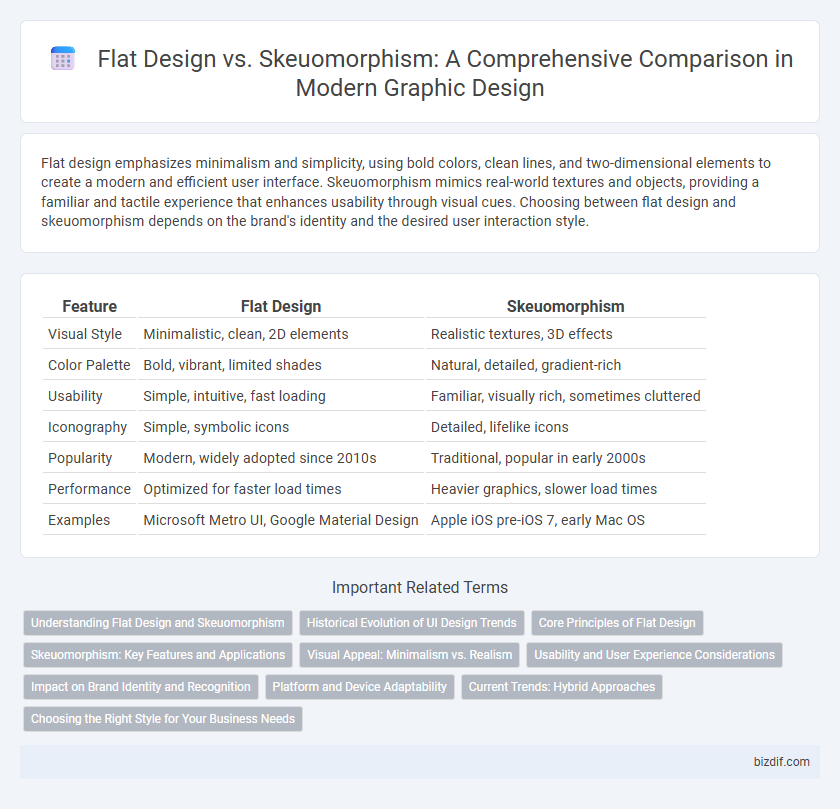Flat design emphasizes minimalism and simplicity, using bold colors, clean lines, and two-dimensional elements to create a modern and efficient user interface. Skeuomorphism mimics real-world textures and objects, providing a familiar and tactile experience that enhances usability through visual cues. Choosing between flat design and skeuomorphism depends on the brand's identity and the desired user interaction style.
Table of Comparison
| Feature | Flat Design | Skeuomorphism |
|---|---|---|
| Visual Style | Minimalistic, clean, 2D elements | Realistic textures, 3D effects |
| Color Palette | Bold, vibrant, limited shades | Natural, detailed, gradient-rich |
| Usability | Simple, intuitive, fast loading | Familiar, visually rich, sometimes cluttered |
| Iconography | Simple, symbolic icons | Detailed, lifelike icons |
| Popularity | Modern, widely adopted since 2010s | Traditional, popular in early 2000s |
| Performance | Optimized for faster load times | Heavier graphics, slower load times |
| Examples | Microsoft Metro UI, Google Material Design | Apple iOS pre-iOS 7, early Mac OS |
Understanding Flat Design and Skeuomorphism
Flat design emphasizes simplicity through minimalistic elements, bold colors, and two-dimensional icons, enhancing user interface clarity and performance. Skeuomorphism replicates real-world textures and details to create familiar, tactile experiences, often using shadows, gradients, and intricate visuals. Understanding these design philosophies is crucial for choosing the right aesthetic and functionality in digital product development.
Historical Evolution of UI Design Trends
Flat design originates from the minimalist movement of the early 2010s, emphasizing simplicity, bold colors, and clean typography, contrasting sharply with skeuomorphism, which gained popularity in the 2000s for its realistic textures and lifelike elements. Skeuomorphism aimed to mimic real-world objects to enhance user familiarity, while flat design emerged as a response seeking efficiency and clarity in digital interfaces. The shift reflects evolving user preferences and advancements in display technologies that favor responsive, scalable, and faster-loading UI designs.
Core Principles of Flat Design
Flat design emphasizes simplicity, utilizing clean, two-dimensional elements, bold colors, and minimalistic typography to enhance user experience. It avoids embellishments like gradients, shadows, and textures, focusing instead on clarity and functionality. This design approach improves interface speed and scalability while promoting intuitive navigation across digital platforms.
Skeuomorphism: Key Features and Applications
Skeuomorphism in graphic design replicates real-world textures and objects to create intuitive interfaces, enhancing user familiarity through detailed shadows, gradients, and tactile elements. Key features include depth perception, realistic lighting effects, and elaborate iconography that mimic physical counterparts, which improve user engagement by evoking a sense of tangible interaction. Common applications appear in digital dashboards, mobile apps, and e-commerce sites where visual realism aids usability and emotional connection with digital products.
Visual Appeal: Minimalism vs. Realism
Flat design emphasizes minimalism with clean lines, bold colors, and simple typography, creating a visually appealing interface that enhances usability and speeds up loading times. Skeuomorphism prioritizes realism by mimicking real-world materials and textures, providing tactile familiarity that helps users intuitively navigate digital environments. The choice between flat design and skeuomorphism significantly impacts user engagement, depending on whether clarity or immersive detail aligns better with the design goals.
Usability and User Experience Considerations
Flat design enhances usability by offering clean, minimalistic visuals that reduce cognitive load and improve navigation speed, making interfaces intuitive and efficient. Skeuomorphism leverages familiar real-world textures and objects, aiding user recognition and providing comfort but may lead to visual clutter that hinders quick task completion. Balancing both approaches depends on user goals, with flat design excelling in streamlined workflows and skeuomorphism supporting learnability through metaphorical cues.
Impact on Brand Identity and Recognition
Flat design enhances brand identity by emphasizing simplicity and clarity, allowing logos and graphics to be easily recognizable across digital platforms, which supports consistent brand recognition. Skeuomorphism, with its realistic textures and details, creates a tangible, familiar feel that can evoke emotional connections and reinforce brand storytelling but may reduce scalability and versatility. Choosing between flat design and skeuomorphism impacts how brands communicate values, with flat design favoring modern minimalism and skeuomorphism offering nostalgic authenticity.
Platform and Device Adaptability
Flat design offers high adaptability across platforms and devices due to its minimalist elements and scalable vector graphics, ensuring faster load times and consistent user experience on smartphones, tablets, and desktops. Skeuomorphism, relying on detailed textures and shadows, often challenges responsiveness and can slow performance on lower-end devices or varying screen sizes. Prioritizing performance and smooth interaction, flat design aligns better with modern multi-platform ecosystems and diverse user environments.
Current Trends: Hybrid Approaches
Current trends in graphic design reveal a growing preference for hybrid approaches that blend flat design's simplicity with skeuomorphism's realistic elements, creating visually engaging yet user-friendly interfaces. Designers integrate subtle textures, shadows, and gradients within flat layouts to enhance depth and interactivity without overwhelming the user. This fusion caters to modern demands for clarity and aesthetic appeal, optimizing user experience across digital platforms.
Choosing the Right Style for Your Business Needs
Flat design offers simplicity and faster load times, ideal for businesses prioritizing clean, modern aesthetics and user-friendly interfaces. Skeuomorphism enhances realism and tactile experience, benefiting brands that aim to evoke familiarity and trust through visual metaphor. Selecting the appropriate style depends on target audience, brand identity, and the desired emotional connection with users.
Flat Design vs Skeuomorphism Infographic

 bizdif.com
bizdif.com